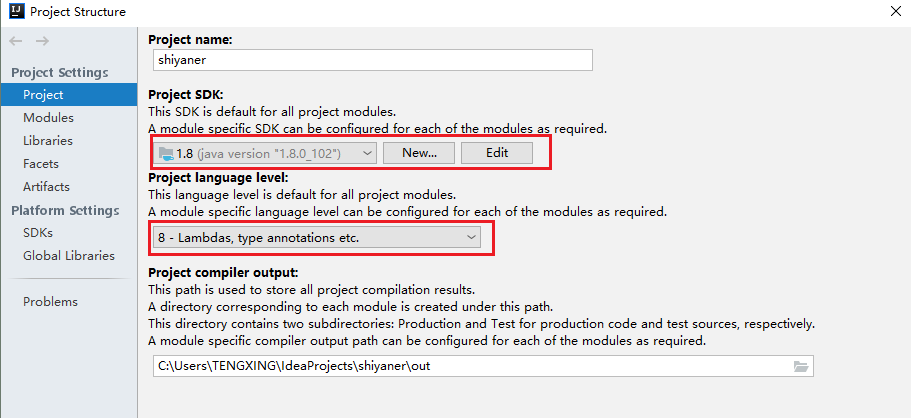2018-2019-2 20175230 实验五《网络编程与安全》实验报告
任务一
实验要求
两人一组结对编程:
0. 参考http://www.cnblogs.com/rocedu/p/6766748.html#SECDSA
- 结对实现中缀表达式转后缀表达式的功能 MyBC.java
- 结对实现从上面功能中获取的表达式中实现后缀表达式求值的功能,调用MyDC.java
- 上传测试代码运行结果截图和码云链接
实验步骤
1.由中缀式求得后缀式可以使用栈,伪代码如下:
设立一个栈,存放运算符,首先栈为空;
从左到右扫描中缀式,若遇到操作数,直接输出,并输出一个空格作为两个操作数的分隔符;
若遇到运算符,则与栈顶比较,比栈顶级别高则进栈,否则退出栈顶元素并输出,然后输出一个空格作分隔符;
若遇到左括号,进栈;若遇到右括号,则一直退栈输出,直到退到左括号止。
当栈变成空时,输出的结果即为后缀表达式。
2.实验代码
中缀表达式转后缀表达式
public class MyBC {
public static String toPostfix(String expr){
MyStack<String> stack = new MyStack<>(expr.length());
String postfix = "";
int i = 0;
while(i<expr.length()){
char ch = expr.charAt(i);
switch (ch){
case '+':
case '-':while(!stack.isEmpty() && !stack.get().equals("("))
postfix += stack.pop();
//postfix += " ";
stack.push(ch + "");
i++;
break;
case '*':
case '/':while (!stack.isEmpty() && (stack.get().equals("*")||stack.get().equals("/")))
postfix += stack.pop();
//postfix += " ";
stack.push(ch + "");
i++;
break;
case '(':stack.push(ch + "");
i++;
break;
case ')':String out = stack.pop();
while(out!=null && !out.equals("(")){
postfix += out;
out = stack.pop();
//postfix += " ";
}
i++;
break;
default:while(i < expr.length() && ch>='0' && ch<='9'){
postfix += ch;
i++;
if(i<expr.length())
ch = expr.charAt(i);
}
postfix += " ";
}
}
while (!stack.isEmpty())
postfix += stack.pop();
return postfix;
}
}
后缀表达式求值
import java.util.Stack;
public class MyDC {
/** constant for addition symbol */
private final char ADD = '+';
/** constant for subtraction symbol */
private final char SUBTRACT = '-';
/** constant for multiplication symbol */
private final char MULTIPLY = '*';
/** constant for division symbol */
private final char DIVIDE = '/';
public int value(String postfix){
Stack<Integer> stack = new Stack();
int i = 0, result = 0;
while(i < postfix.length()){
char ch = postfix.charAt(i);
if(ch>='0' && ch<='9'){
result = 0;
while(ch!=' '){
result = result*10 + Integer.parseInt(ch+"");
i++;
ch = postfix.charAt(i);
}
i++;
stack.push(new Integer(result));
}
else{
int y = stack.pop().intValue();
int x = stack.pop().intValue();
switch (ch){
case ADD:
result = x + y;
break;
case SUBTRACT:
result = x - y;
break;
case MULTIPLY:
result = x * y;
break;
case DIVIDE:
result = x / y;
}
stack.push(new Integer(result));
i++;
}
}
return stack.pop().intValue();
}
}
3.实验截图
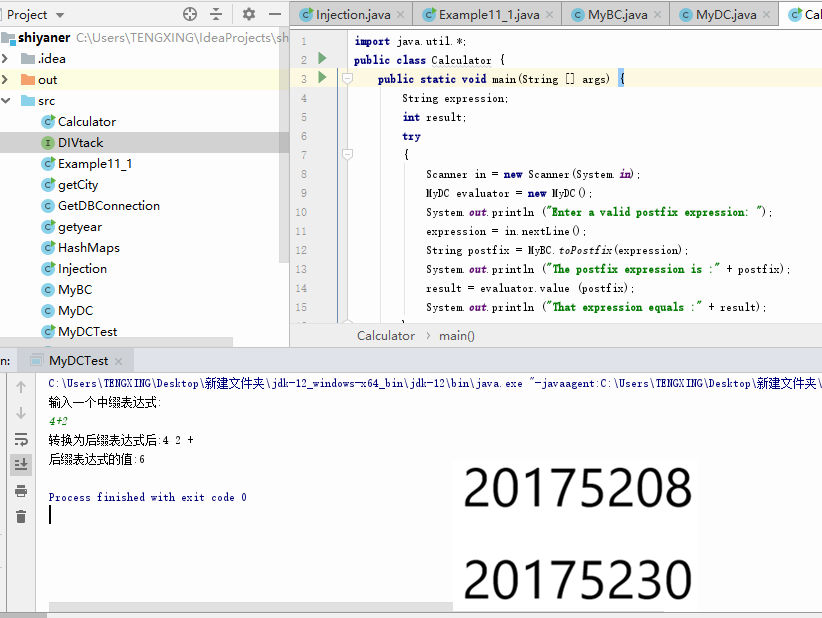
任务二
实验内容
结对编程:1人负责客户端,一人负责服务器
0. 注意责任归宿,要会通过测试证明自己没有问题
- 基于Java Socket实现客户端/服务器功能,传输方式用TCP
- 客户端让用户输入中缀表达式,然后把中缀表达式调用MyBC.java的功能转化为后缀表达式,把后缀表达式通过网络发送给服务器
- 服务器接收到后缀表达式,调用MyDC.java的功能计算后缀表达式的值,把结果发送给客户端
- 客户端显示服务器发送过来的结果
- 上传测试结果截图和码云链接
实验步骤
一、搭建服务器端
a)、创建ServerSocket对象绑定监听端口。
b)、通过accept()方法监听客户端的请求。
c)、建立连接后,通过输入输出流读取客户端发送的请求信息。
d)、通过输出流向客户端发送请求信息。
e)、关闭相关资源。
二、搭建客户器端
a)、创建Socket对象,指明需要连接的服务器的地址和端口。
b)、建立连接后,通过输出流向服务器发送请求信息。
c)、通过输入流获取服务器的响应信息。
d)、关闭响应资源
三、查看自己电脑的IP地址
import java.net.*;
public class Address {
public static void main(String[] args) throws UnknownHostException {
InetAddress net = InetAddress.getLocalHost();
System.out.println(net.toString());
}
}
四、实验代码
客户端
import java.io.*;
import java.net.*;
public class Server2 {
public static void main(String args[]) {
int answer;
ServerSocket serverForClient=null;
Socket socketOnServer=null;
DataOutputStream out=null;
DataInputStream in=null;
try { serverForClient = new ServerSocket(2010);
}
catch(IOException e1) {
System.out.println(e1);
}
try{ System.out.println("等待客户呼叫");
socketOnServer = serverForClient.accept(); //堵塞状态,除非有客户呼叫
out=new DataOutputStream(socketOnServer.getOutputStream());
in=new DataInputStream(socketOnServer.getInputStream());
String s=in.readUTF(); // in读取信息,堵塞状态
System.out.println("服务器收到客户的提问:"+s);
MyDC d=new MyDC();
answer=d.evaluate(s);
out.writeUTF(answer+"");
Thread.sleep(500);
}
catch(Exception e) {
System.out.println("客户已断开"+e);
}
}
}
服务端
import java.io.*;
import java.net.*;
public class Server2 {
public static void main(String args[]) {
int answer;
ServerSocket serverForClient=null;
Socket socketOnServer=null;
DataOutputStream out=null;
DataInputStream in=null;
try { serverForClient = new ServerSocket(2010);
}
catch(IOException e1) {
System.out.println(e1);
}
try{ System.out.println("等待客户呼叫");
socketOnServer = serverForClient.accept(); //堵塞状态,除非有客户呼叫
out=new DataOutputStream(socketOnServer.getOutputStream());
in=new DataInputStream(socketOnServer.getInputStream());
String s=in.readUTF(); // in读取信息,堵塞状态
System.out.println("服务器收到客户的提问:"+s);
MyDC d=new MyDC();
answer=d.evaluate(s);
out.writeUTF(answer+"");
Thread.sleep(500);
}
catch(Exception e) {
System.out.println("客户已断开"+e);
}
}
}
实验结果
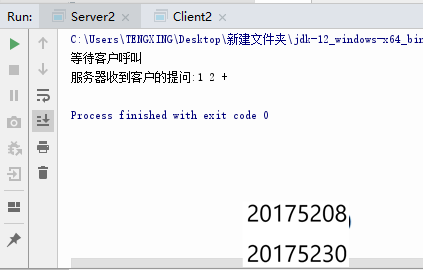
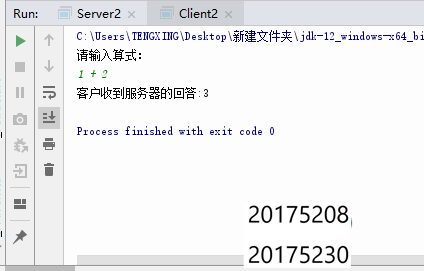
任务三
实验内容
加密结对编程:1人负责客户端,一人负责服务器
0. 注意责任归宿,要会通过测试证明自己没有问题
- 基于Java Socket实现客户端/服务器功能,传输方式用TCP
- 客户端让用户输入中缀表达式,然后把中缀表达式调用MyBC.java的功能转化为后缀表达式,把后缀表达式用3DES或AES算法加密后通过网络把密文发送给服务器
- 服务器接收到后缀表达式表达式后,进行解密(和客户端协商密钥,可以用数组保存),然后调用MyDC.java的功能计算后缀表达式的值,把结果发送给客户端
- 客户端显示服务器发送过来的结果
- 上传测试结果截图和码云链接
实验步骤
实现DES加密主要有以下几个步骤:
对称密钥的生成和保存;
使用对称密钥进行加密和解密;
从文件中获取加密时使用的密钥,使用密钥进行解密。
实验代码
服务端
import java.io.*;
import java.net.*;
public class ServerOne {
public static void main (String args[]) throws Exception {
/*String key="";
int n=-1;
byte [] a=new byte[128];
try{ File f=new File("key1.dat");
InputStream in = new FileInputStream(f);
while((n=in.read(a,0,100))!=-1) {
key=key+new String (a,0,n);
}
in.close();
}
catch(IOException e) {
System.out.println("File read Error"+e);
}*/
ServerSocket serverForClient=null;
Socket socketOnServer=null;
DataOutputStream out=null;
DataInputStream in=null;
try { serverForClient = new ServerSocket(2010);
}
catch(IOException e1) {
System.out.println(e1);
}
try{ System.out.println("等待客户呼叫");
socketOnServer = serverForClient.accept(); //堵塞状态,除非有客户呼叫
out=new DataOutputStream(socketOnServer.getOutputStream());
in=new DataInputStream(socketOnServer.getInputStream());
String key = in.readUTF();
String s=in.readUTF(); // in读取信息,堵塞状态
System.out.println("服务器收到的信息:"+s);
String clear=Encoder.AESDncode(key,s);
MyDC d=new MyDC();
System.out.println("服务器收到客户的提问:"+clear);
int answer=d.evaluate(clear);
out.writeUTF(answer+"");
Thread.sleep(500);
}
catch(Exception e) {
System.out.println("客户已断开"+e);
}
}
}
客户端
import java.io.*;
import java.net.*;
import java.lang.*;
import java.util.Scanner;
public class ClientOne {
public static void main(String args[]) throws Exception {
String key = "";
int n = -1;
byte[] a = new byte[128];
try {
File f = new File("key1.dat");
InputStream in = new FileInputStream(f);
while ((n = in.read(a, 0, 100)) != -1) {
key = key + new String(a, 0, n);
}
in.close();
} catch (IOException e) {
System.out.println("File read Error" + e);
}
Socket mysocket;
DataInputStream in = null;
DataOutputStream out = null;
System.out.println("请输入算式:");
Scanner scanner = new Scanner(System.in);
String str = scanner.nextLine();//输入算式
MyBC b = new MyBC();
str = b.result(str);
String secret=Encoder.AESEncode(key,str);//客户端进行加密
try {
mysocket = new Socket("127.1.0.0", 2010);
in = new DataInputStream(mysocket.getInputStream());
out = new DataOutputStream(mysocket.getOutputStream());
out.writeUTF(key);
out.writeUTF(secret);
String s = in.readUTF(); //in读取信息,堵塞状态
System.out.println("客户收到服务器的回答:" + s);
Thread.sleep(500);
} catch (Exception e) {
System.out.println("服务器已断开" + e);
}
}
}
加解密代码
import java.io.IOException;
import java.io.UnsupportedEncodingException;
import java.security.InvalidKeyException;
import java.security.NoSuchAlgorithmException;
import java.security.SecureRandom;
import java.util.Base64;
import java.util.Scanner;
import javax.crypto.BadPaddingException;
import javax.crypto.Cipher;
import javax.crypto.IllegalBlockSizeException;
import javax.crypto.KeyGenerator;
import javax.crypto.NoSuchPaddingException;
import javax.crypto.SecretKey;
import javax.crypto.spec.SecretKeySpec;
import sun.misc.BASE64Decoder;
import sun.misc.BASE64Encoder;
/*
* AES对称加密和解密
*/
public class Encoder {
/*
* 加密
* 1.构造密钥生成器
* 2.根据ecnodeRules规则初始化密钥生成器
* 3.产生密钥
* 4.创建和初始化密码器
* 5.内容加密
* 6.返回字符串
*/
public static String AESEncode(String encodeRules,String content){
try {
//1.构造密钥生成器,指定为AES算法,不区分大小写
KeyGenerator keygen=KeyGenerator.getInstance("AES");
//2.根据ecnodeRules规则初始化密钥生成器
//生成一个128位的随机源,根据传入的字节数组
keygen.init(128, new SecureRandom(encodeRules.getBytes()));
//3.产生原始对称密钥
SecretKey original_key=keygen.generateKey();
//4.获得原始对称密钥的字节数组
byte [] raw=original_key.getEncoded();
//5.根据字节数组生成AES密钥
SecretKey key=new SecretKeySpec(raw, "AES");
//6.根据指定算法AES自成密码器
Cipher cipher=Cipher.getInstance("AES");
//7.初始化密码器,第一个参数为加密(Encrypt_mode)或者解密解密(Decrypt_mode)操作,第二个参数为使用的KEY
cipher.init(Cipher.ENCRYPT_MODE, key);
//8.获取加密内容的字节数组(这里要设置为utf-8)不然内容中如果有中文和英文混合中文就会解密为乱码
byte [] byte_encode=content.getBytes("utf-8");
//9.根据密码器的初始化方式--加密:将数据加密
byte [] byte_AES=cipher.doFinal(byte_encode);
//10.将加密后的数据转换为字符串
//这里用Base64Encoder中会找不到包
//解决办法:
//在项目的Build path中先移除JRE System Library,再添加库JRE System Library,重新编译后就一切正常了。
String AES_encode=new String(new BASE64Encoder().encode(byte_AES));
//11.将字符串返回
return AES_encode;
} catch (NoSuchAlgorithmException e) {
e.printStackTrace();
} catch (NoSuchPaddingException e) {
e.printStackTrace();
} catch (InvalidKeyException e) {
e.printStackTrace();
} catch (IllegalBlockSizeException e) {
e.printStackTrace();
} catch (BadPaddingException e) {
e.printStackTrace();
} catch (UnsupportedEncodingException e) {
e.printStackTrace();
}
//如果有错就返加nulll
return null;
}
/*
* 解密
* 解密过程:
* 1.同加密1-4步
* 2.将加密后的字符串反纺成byte[]数组
* 3.将加密内容解密
*/
public static String AESDncode(String encodeRules,String content){
try {
//1.构造密钥生成器,指定为AES算法,不区分大小写
KeyGenerator keygen=KeyGenerator.getInstance("AES");
//2.根据ecnodeRules规则初始化密钥生成器
//生成一个128位的随机源,根据传入的字节数组
keygen.init(128, new SecureRandom(encodeRules.getBytes()));
//3.产生原始对称密钥
SecretKey original_key=keygen.generateKey();
//4.获得原始对称密钥的字节数组
byte [] raw=original_key.getEncoded();
//5.根据字节数组生成AES密钥
SecretKey key=new SecretKeySpec(raw, "AES");
//6.根据指定算法AES自成密码器
Cipher cipher=Cipher.getInstance("AES");
//7.初始化密码器,第一个参数为加密(Encrypt_mode)或者解密(Decrypt_mode)操作,第二个参数为使用的KEY
cipher.init(Cipher.DECRYPT_MODE, key);
//8.将加密并编码后的内容解码成字节数组
byte [] byte_content= new BASE64Decoder().decodeBuffer(content);
/*
* 解密
*/
byte [] byte_decode=cipher.doFinal(byte_content);
String AES_decode=new String(byte_decode,"utf-8");
return AES_decode;
} catch (NoSuchAlgorithmException e) {
e.printStackTrace();
} catch (NoSuchPaddingException e) {
e.printStackTrace();
} catch (InvalidKeyException e) {
e.printStackTrace();
} catch (IOException e) {
e.printStackTrace();
} catch (IllegalBlockSizeException e) {
e.printStackTrace();
} catch (BadPaddingException e) {
e.printStackTrace();
}
//如果有错就返加nulll
return null;
}
}
AES调用代码
import java.io.*;
import javax.crypto.*;
public class Skey_AES{
public static void main(String args[]) throws Exception{
KeyGenerator kg=KeyGenerator.getInstance("AES");
kg.init(128);
SecretKey k=kg.generateKey( );
FileOutputStream f=new FileOutputStream("key1.dat");
ObjectOutputStream b=new ObjectOutputStream(f);
b.writeObject(k);
}
}
实验截图
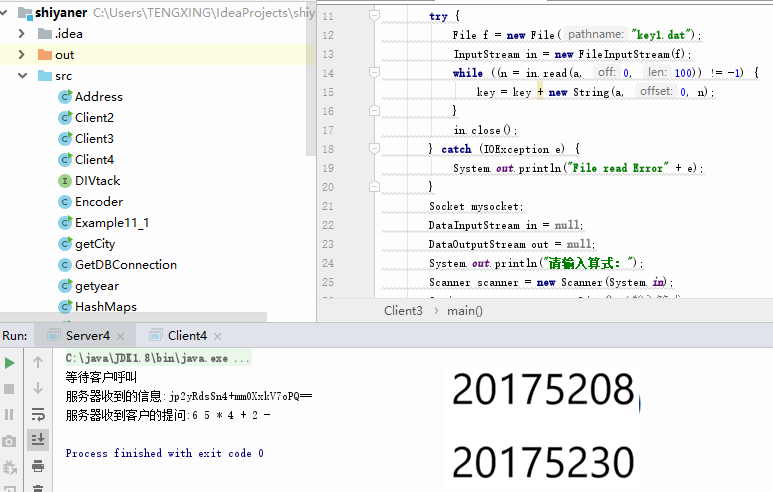
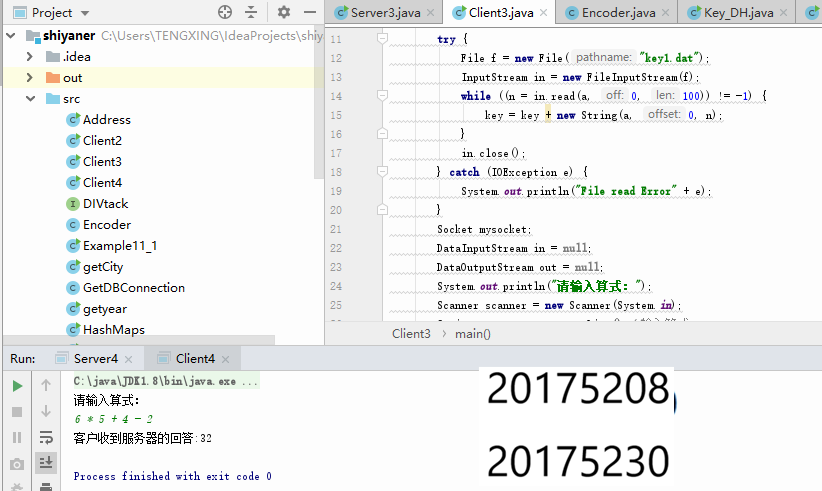
任务四
实验内容
密钥分发结对编程:1人负责客户端,一人负责服务器
0. 注意责任归宿,要会通过测试证明自己没有问题
- 基于Java Socket实现客户端/服务器功能,传输方式用TCP
- 客户端让用户输入中缀表达式,然后把中缀表达式调用MyBC.java的功能转化为后缀表达式,把后缀表达式用3DES或AES算法加密通过网络把密文发送给服务器
- 客户端和服务器用DH算法进行3DES或AES算法的密钥交换
- 服务器接收到后缀表达式表达式后,进行解密,然后调用MyDC.java的功能计算后缀表达式的值,把结果发送给客户端
- 客户端显示服务器发送过来的结果
- 上传测试结果截图和码云链接
实验步骤
1.执行密钥协定的标准算法是DH算法(Diffie-Hellman算法),分为以下两步:
创建DH公钥和私钥;
创建共享密钥。
2.然后在前面任务的基础上分别运行客户端和服务器
3.实验代码
DH公钥
import javax.crypto.spec.DHParameterSpec;
import java.io.FileOutputStream;
import java.io.ObjectOutputStream;
import java.math.BigInteger;
import java.security.KeyPair;
import java.security.KeyPairGenerator;
import java.security.PrivateKey;
import java.security.PublicKey;
public class Key_DH{
//三个静态变量的定义从
// C:j2sdk-1_4_0-docdocsguidesecurityjceJCERefGuide.html
// 拷贝而来
// The 1024 bit Diffie-Hellman modulus values used by SKIP
private static final byte skip1024ModulusBytes[] = {
(byte)0xF4, (byte)0x88, (byte)0xFD, (byte)0x58,
(byte)0x4E, (byte)0x49, (byte)0xDB, (byte)0xCD,
(byte)0x20, (byte)0xB4, (byte)0x9D, (byte)0xE4,
(byte)0x91, (byte)0x07, (byte)0x36, (byte)0x6B,
(byte)0x33, (byte)0x6C, (byte)0x38, (byte)0x0D,
(byte)0x45, (byte)0x1D, (byte)0x0F, (byte)0x7C,
(byte)0x88, (byte)0xB3, (byte)0x1C, (byte)0x7C,
(byte)0x5B, (byte)0x2D, (byte)0x8E, (byte)0xF6,
(byte)0xF3, (byte)0xC9, (byte)0x23, (byte)0xC0,
(byte)0x43, (byte)0xF0, (byte)0xA5, (byte)0x5B,
(byte)0x18, (byte)0x8D, (byte)0x8E, (byte)0xBB,
(byte)0x55, (byte)0x8C, (byte)0xB8, (byte)0x5D,
(byte)0x38, (byte)0xD3, (byte)0x34, (byte)0xFD,
(byte)0x7C, (byte)0x17, (byte)0x57, (byte)0x43,
(byte)0xA3, (byte)0x1D, (byte)0x18, (byte)0x6C,
(byte)0xDE, (byte)0x33, (byte)0x21, (byte)0x2C,
(byte)0xB5, (byte)0x2A, (byte)0xFF, (byte)0x3C,
(byte)0xE1, (byte)0xB1, (byte)0x29, (byte)0x40,
(byte)0x18, (byte)0x11, (byte)0x8D, (byte)0x7C,
(byte)0x84, (byte)0xA7, (byte)0x0A, (byte)0x72,
(byte)0xD6, (byte)0x86, (byte)0xC4, (byte)0x03,
(byte)0x19, (byte)0xC8, (byte)0x07, (byte)0x29,
(byte)0x7A, (byte)0xCA, (byte)0x95, (byte)0x0C,
(byte)0xD9, (byte)0x96, (byte)0x9F, (byte)0xAB,
(byte)0xD0, (byte)0x0A, (byte)0x50, (byte)0x9B,
(byte)0x02, (byte)0x46, (byte)0xD3, (byte)0x08,
(byte)0x3D, (byte)0x66, (byte)0xA4, (byte)0x5D,
(byte)0x41, (byte)0x9F, (byte)0x9C, (byte)0x7C,
(byte)0xBD, (byte)0x89, (byte)0x4B, (byte)0x22,
(byte)0x19, (byte)0x26, (byte)0xBA, (byte)0xAB,
(byte)0xA2, (byte)0x5E, (byte)0xC3, (byte)0x55,
(byte)0xE9, (byte)0x2F, (byte)0x78, (byte)0xC7
};
// The SKIP 1024 bit modulus
private static final BigInteger skip1024Modulus
= new BigInteger(1, skip1024ModulusBytes);
// The base used with the SKIP 1024 bit modulus
private static final BigInteger skip1024Base = BigInteger.valueOf(2);
public static void main(String args[ ]) throws Exception{
DHParameterSpec DHP=
new DHParameterSpec(skip1024Modulus,skip1024Base);
KeyPairGenerator kpg= KeyPairGenerator.getInstance("DH");
kpg.initialize(DHP);
KeyPair kp=kpg.genKeyPair();
PublicKey pbk=kp.getPublic();
PrivateKey prk=kp.getPrivate();
// 保存公钥
FileOutputStream f1=new FileOutputStream(args[0]);
ObjectOutputStream b1=new ObjectOutputStream(f1);
b1.writeObject(pbk);
// 保存私钥
FileOutputStream f2=new FileOutputStream(args[1]);
ObjectOutputStream b2=new ObjectOutputStream(f2);
b2.writeObject(prk);
}
}
import javax.crypto.KeyAgreement;
import javax.crypto.spec.SecretKeySpec;
import java.io.*;
import java.security.PrivateKey;
import java.security.PublicKey;
public class KeyAgree{
public static void main(String args[ ]) throws Exception{
File file=new File("Sharekey.dat");
// 读取对方的DH公钥
FileInputStream f1=new FileInputStream("Apub.dat");
ObjectInputStream b1=new ObjectInputStream(f1);
PublicKey pbk=(PublicKey)b1.readObject( );
//读取自己的DH私钥
FileInputStream f2=new FileInputStream("Bpri.dat");
ObjectInputStream b2=new ObjectInputStream(f2);
PrivateKey prk=(PrivateKey)b2.readObject( );
// 执行密钥协定
KeyAgreement ka=KeyAgreement.getInstance("DH");
ka.init(prk);
ka.doPhase(pbk,true);
//生成共享信息
byte[ ] sb=ka.generateSecret();
for(int i=0;i<sb.length;i++){
System.out.print(sb[i]+",");
}
OutputStream out=new FileOutputStream(file);
out.write(sb);
out.close();
SecretKeySpec k=new SecretKeySpec(sb,"AES");
}
}
实验结果
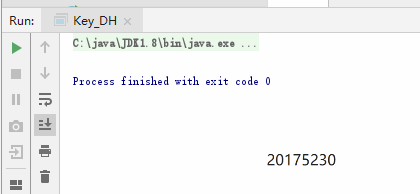


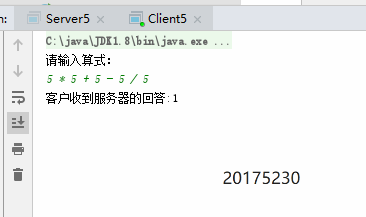
任务五
实验内容:
完整性校验结对编程:1人负责客户端,一人负责服务器;
(1)注意责任归宿,要会通过测试证明自己没有问题;
(2)基于Java Socket实现客户端/服务器功能,传输方式用TCP;
(3)客户端让用户输入中缀表达式,然后把中缀表达式调用MyBC.java的功能转化为后缀表达式,把后缀表达式用3DES或AES算法加密通过网络把密文和明文的MD5値发送给服务器;
(4)客户端和服务器用DH算法进行3DES或AES算法的密钥交换;
(5)服务器接收到后缀表达式表达式后,进行解密,解密后计算明文的MD5值,和客户端传来的MD5进行比较,一致则调用MyDC.java的功能计算后缀表达式的值,把结果发送给客户端;
(6)客户端显示服务器发送过来的结果;
(7)上传测试结果截图和码云链接;
实验步骤
可以使用Java计算指定字符串的消息摘要。java.security包中的MessageDigest类提供了计算消息摘要的方法,首先生成对象,执行其update()方法可以将原始数据传递给该对象,然后执行其digest( )方法即可得到消息摘要。
实验代码
import java.security.*;
public class DigestPass{
static String MD5(String str) throws Exception{
MessageDigest m=MessageDigest.getInstance("MD5");
m.update(str.getBytes("UTF8"));
byte s[ ]=m.digest( );
String result="";
for (int i=0; i<s.length; i++){
result+=Integer.toHexString((0x000000ff & s[i]) |
0xffffff00).substring(6);
}
return result;
}
}
客户端
import java.io.*;
import java.net.*;
public class Server6 {
public static void main(String args[]) throws IOException{
String sharekey="";
int n=-1;
byte [] a=new byte[128];
try{ File f=new File("Sharekey.dat");
InputStream in = new FileInputStream(f);
while((n=in.read(a,0,100))!=-1) {
sharekey=sharekey+new String (a,0,n);
}
in.close();
}
catch(IOException e) {
System.out.println("File read Error"+e);
}
ServerSocket serverForClient=null;
Socket socketOnServer=null;
DataOutputStream out=null;
DataInputStream in=null;
try { serverForClient = new ServerSocket(2010);
}
catch(IOException e1) {
System.out.println(e1);
}
try{ System.out.println("等待客户呼叫");
socketOnServer = serverForClient.accept(); //堵塞状态,除非有客户呼叫
out=new DataOutputStream(socketOnServer.getOutputStream());
in=new DataInputStream(socketOnServer.getInputStream());
String keyone =in.readUTF();//读取被DH算法加密的密钥
String truekey = Encoder.AESDncode(sharekey,keyone);//使用共享密钥对被加密的原密钥解密。
String secret =in.readUTF(); // in读取信息,堵塞状态
System.out.println("服务器收到的信息:"+secret);
String mdClient=in.readUTF();
System.out.println("客户端提供的MD5为:"+ mdClient);
String clear = Encoder.AESDncode(truekey,secret);//使用原密钥解密表达式
MyDC d=new MyDC();
int answer=d.evaluate(clear);
if((mdClient.equals(DigestPass.MD5(clear)))==true) {//判断MD5值是否相等,若相等,则返回答案
System.out.println("MD5值匹配");
System.out.println("服务器提供的解密:" + clear);
System.out.println("服务器解出密文的MD5为:" + DigestPass.MD5(clear));
out.writeUTF(answer + "");
}
Thread.sleep(500);
}
catch(Exception e) {
System.out.println("客户已断开"+e);
}
}
}
服务端
import java.io.*;
import java.net.*;
import java.util.Scanner;
public class Client {
public static void main(String args[]) throws Exception {
String key1="";
int n1=-1;
byte [] a1=new byte[128];
try{ File f=new File("key1.dat");
InputStream in = new FileInputStream(f);
while((n1=in.read(a1,0,100))!=-1) {
key1=key1+new String (a1,0,n1);
}
in.close();
}
catch(IOException e) {
System.out.println("File read Error"+e);
}
String sharekey="";
int n=-1;
byte [] a=new byte[128];
try{ File f=new File("Sharekey.dat");
InputStream in = new FileInputStream(f);
while((n=in.read(a,0,100))!=-1) {
sharekey=sharekey+new String (a,0,n);
}
in.close();
}
catch(IOException e) {
System.out.println("File read Error"+e);
}
Socket mysocket;
DataInputStream in=null;
DataOutputStream out=null;
System.out.println("请输入算式:");
Scanner scanner = new Scanner(System.in);
String str = scanner.nextLine();//输入算式
MyBC b=new MyBC();
str=b.result(str);
String secret=Encoder.AESEncode(key1, str);//客户端对表达式进行加密
String md=DigestPass.MD5(str);//客户端提供的MD5
key1 = Encoder.AESEncode(sharekey,key1);//客户端对密钥进行DH加密
try{ mysocket=new Socket("127.1.0.0",2010);
in=new DataInputStream(mysocket.getInputStream());
out=new DataOutputStream(mysocket.getOutputStream());
out.writeUTF(key1);
out.writeUTF(secret);
out.writeUTF(md);
String s=in.readUTF(); //in读取信息,堵塞状态
System.out.println("客户收到服务器的回答:"+s);
Thread.sleep(50000);
}
catch(Exception e) {
System.out.println("服务器已断开"+e);
}
}
}
实验结果
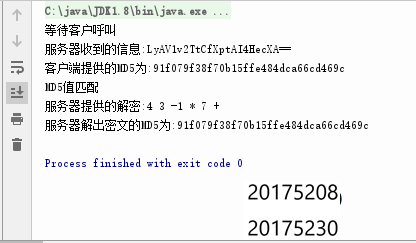
实验过程中的问题与解决方法
-
问题一 在做任务三时,当编译加解密代码Encoder时,
import sun.misc.BASE64Decoder; import sun.misc.BASE64Encoder;出错

-
问题一的解决方法 百度后得知,由于JDK12版本中没有这两个包,因此下载使用JDK1.8即可
-
问题二 任务三中下载安装JDK1.8后,仍然无法正常编译,出现
Error:java: 无效的源发行版: 11的错误 -
问题二的解决方法 主要原因是:本机的JDK版本与项目的语言级别不同造成的,因此使用Ctrl+Alt+Shift+s打开Project Structure,选择project,然后选择Project Language Level中的8即可
